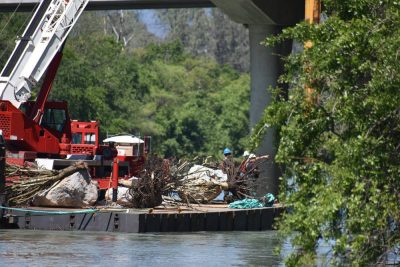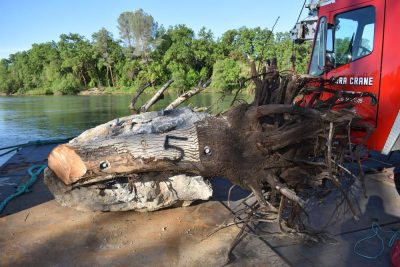Sacramento River Fish Report for 5-9-2017
First-of-its-kind California Chinook Salmon Restoration Project
Sacramento River - CA

by Maven's Notebook
5-9-2017
For young salmon in the northern Sacramento River, life may get easier thanks to an innovative effort developed by a coalition of farmers, state and federal agencies, and environmental groups that are working to increase the chinook salmon population.
River Garden Farms of Knights Landing recently installed 25 new salmon shelter structures in the river near Redding – new habitats for salmon that are made of large tree trunks and root wads bolted to 12,000 pound limestone boulders.
The structures are intended to help baby salmon hide out and give them refuge against large predators, while enticing them to stay in colder waters longer, increasing their odds of healthy maturation for their journey to the Pacific Ocean.
“Protecting the Chinook salmon and helping to restore their population is the right thing to do for the overall health of the Sacramento River and the vital ecosystem that relies on the river to flourish,” said Roger Cornwell, General Manager of River Garden Farms in Knights Landing. “As members of this community who have been farming along the river since 1913, it is vital that we all work together to ensure the Chinook salmon have shelters to help prepare them for their journey to the Pacific Ocean and back.”
The salmon shelters project is one of more than 50 projects taking place as part of the Sacramento Valley Salmon Recovery Program, which has brought partners together to advance innovative and comprehensive projects to enhance the passage of and habitat for salmon.
“The River Garden Farms salmon shelter project is another great example of the collaborative effort underway in the Sacramento Valley, engaging a diverse group of entities, to promote salmon recovery in an innovative and comprehensive manner,” said David Guy, President, Northern California Water Association. “The Sacramento Valley Salmon Recovery Program, and the partnerships that make it possible, represents a truly unique approach and is a model for managing precious water resources for multiple beneficial uses.”
Partnerships between the Sacramento River Settlement Contractors, federal and state agencies and solution-oriented environmental groups under the Sacramento Valley Salmon Recovery Program have led to tremendous progress on projects that have had a positive impact on salmon, yet more work is ahead.
“We are pleased to work with the entire Sacramento River Valley community to play a part in this effort to improve the river for salmon,” Cornwell said. “Working together, a diverse group of businesses, public agencies and non-profit organizations is making a difference in improving the river and the ecosystem.”
Each year, Chinook salmon travel nearly 300 miles from the Pacific Ocean through the San Francisco Bay up the Sacramento River to desired spawning sites.
While salmon spawn in the fall, the Sacramento River is the only river in the world that has four salmon runs due to its intrinsic ecosystem that features near year-round cold water due to snow melt, abundant food supply, water velocity, water depth and riverbed gravel. When one or all of these are drastically altered, fish populations are impacted.
River Garden Farms was the primary funder of the project, which cost more than $600,000, with funding also coming from the U.S. Bureau of Reclamation. Additional partners vital to the shelters project include Northern California Water Association, National Marine Fisheries Service, and the Western Shasta Resource Conservation District.
About the Sacramento Valley Salmon Recovery Program
The Sacramento Valley Salmon Recovery Program has brought partners together to advance innovative and comprehensive projects to enhance the passage of and habitat for salmon. Partnerships between the Sacramento River Settlement Contractors, federal and state agencies and solution-oriented environmental groups under the Sacramento Valley Salmon Recovery Program have led to tremendous progress on projects that have had a positive impact on salmon, yet more work is ahead. The next generation of salmon projects that will aid the survival of the species focus on fish passage improvements and high-priority fish screens, flow management, and habitat improvements.
Photos
< Previous Report Next Report >
< Previous Report Next Report >
More Reports
5-9-2017The following is an update from the Department of Water Resources (DWR) about construction-related activities on the Lake Oroville Spillways Recovery project. DWR is committed to informing the public about the work being done to repair the damaged spillways and related impacts to roads, recreation, public access and surrounding infrastructure. DWR is improving construction access to the gated (main) spillway for construction activities by using controlled blasting to remove portions of the exposed rock. Blasting is intermittent and will resume on Tuesday,...... Read More

Website Hosting and Design provided by TECK.net
